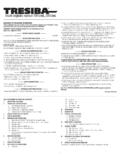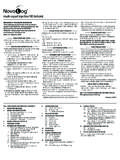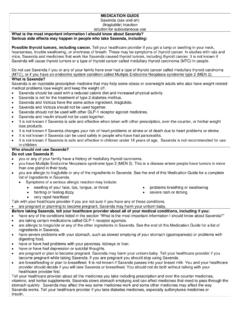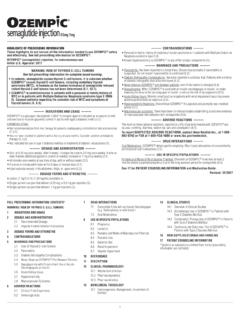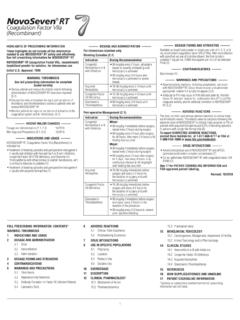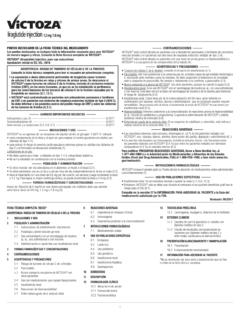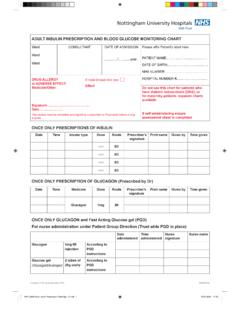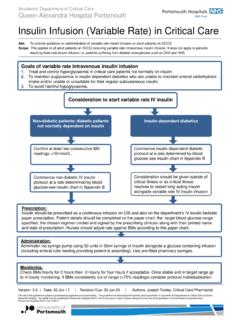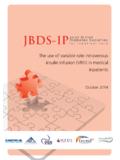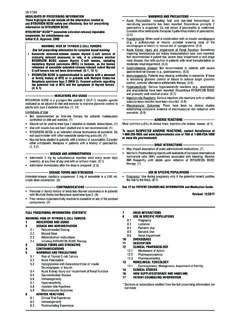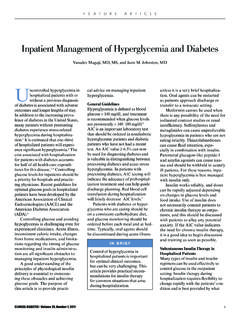Transcription of HIGHLIGHTS OF PRESCRIBING INFORMATION - …
1 1 DOSAGE FORMS AND STRENGTHS Solution for injection 100 Units/mL (U-100) in 3 mL single-patient-use LEVEMIR FlexTouch 10 mL multiple-dose vial (3) CONTRAINDICATIONS Do not use in patients with hypersensitivity to LEVEMIR or any of its excipients (4). WARNINGS AND PRECAUTIONS Never Share a LEVEMIR FlexTouch between patients , even if the needle is changed ( ). Dose adjustment and monitoring: Monitor blood glucose in all patients treated with insulin . insulin regimens should be modified cautiously and only under medical supervision ( ). Administration: Do not dilute or mix with any other insulin or solution.
2 Do not administer subcutaneously via an insulin pump, intramuscularly, or intravenously because severe hypoglycemia can occur ( ). Hypoglycemia is the most common adverse reaction of insulin therapy and may be life-threatening ( , ). Allergic reactions: Severe, life-threatening, generalized allergy, including anaphylaxis, can occur ( ). Renal or hepatic impairment: May require adjustment of the LEVEMIR dose ( , ). Fluid retention and heart failure can occur with concomitant use of thiazolidinediones (TZDs), which are PPAR-gamma agonists, and insulin , including LEVEMIR ( ). ADVERSE REACTIONS Adverse reactions associated with LEVEMIR include hypoglycemia, allergic reactions, injection site reactions, lipodystrophy, rash and pruritus (6).
3 To report SUSPECTED ADVERSE REACTIONS, contact Novo Nordisk Inc. at 1-800-727-6500 or FDA at 1-800-FDA-1088 or DRUG INTERACTIONS Certain drugs may affect glucose metabolism requiring insulin dose adjustment and close monitoring of blood glucose (7). The signs of hypoglycemia may be reduced or absent in patients taking anti-adrenergic drugs ( , beta-blockers, clonidine, guanethidine, and reserpine) (7). USE IN SPECIFIC POPULATIONS Pediatric: Has not been studied in children with type 2 diabetes. Has not been studied in children with type 1 diabetes <2 years of age ( ).See 17 for PATIENT COUNSELING INFORMATION and FDA-approved patient labeling.
4 Revised: 01/2019 FULL PRESCRIBING INFORMATION : CONTENTS*1 INDICATIONS AND USAGE2 DOSAGE AND ADMINISTRATION Dosing Initiation of LEVEMIR Therapy Converting to LEVEMIR from Other insulin Therapies3 DOSAGE FORMS AND STRENGTHS4 CONTRAINDICATIONS5 WARNINGS AND PRECAUTIONS Never Share a LEVEMIR FlexTouch between patients Dosage Adjustment and Monitoring Administration Hypoglycemia Hypersensitivity and Allergic Reactions Renal Impairment Hepatic Impairment Drug Interactions Fluid Retention and Heart Failure with Concomitant Use of PPAR-gamma Agonists6 ADVERSE REACTIONS Clinical Trial Experience
5 Postmarketing Experience7 DRUG INTERACTIONS8 USE IN SPECIFIC POPULATIONS Pregnancy Nursing Mothers Pediatric Use Geriatric Use10 OVERDOSAGE11 DESCRIPTION12 CLINICAL PHARMACOLOGY Mechanism of Action Pharmacodynamics Pharmacokinetics 13 NONCLINICAL TOXICOLOGY Carcinogenesis, Mutagenesis, Impairment of Fertility14 CLINICAL STUDIES16 HOW SUPPLIED/STORAGE AND HANDLING How Supplied Storage Preparation and Handling17 PATIENT COUNSELING INFORMATION Never Share a LEVEMIR FlexTouch between patients Instructions for patients * Sections or subsections omitted from the full PRESCRIBING INFORMATION are not OF PRESCRIBING INFORMATIONT hese HIGHLIGHTS do not include all the INFORMATION needed to use LEVEMIR safely and effectively.
6 See full PRESCRIBING INFORMATION for LEVEMIR .LEVEMIR ( insulin detemir injection), for subcutaneous use Initial Approval: 2005 RECENT MAJOR CHANGES Dosage and Administration ( )..01/2019 INDICATIONS AND USAGE LEVEMIR is a long-acting human insulin analog indicated to improve glycemic control in adults and children with diabetes mellitus (1).Important Limitations of Use: Not recommended for treating diabetic ketoacidosis. Use intravenous, rapid-acting or short-acting insulin instead. DOSAGE AND ADMINISTRATION The starting dose should be individualized based on the type of diabetes and whether the patient is insulin -na ve ( , , ).
7 Administer subcutaneously once daily or in divided doses twice daily. Once daily administration should be given with the evening meal or at bedtime ( ). Rotate injection sites within an injection area (abdomen, thigh, or deltoid) to reduce the risk of lipodystrophy ( ). Converting from other insulin therapies may require adjustment of timing and dose of LEVEMIR . Closely monitor glucoses especially upon converting to LEVEMIR and during the initial weeks thereafter ( ). insulin detemir injection 100 Units/mL2 LEVEMIR ( insulin detemir injection) fluid retention, particularly when used in combination with insulin .
8 Fluid retention may lead to or exacerbate heart failure. patients treated with insulin , including LEVEMIR , and a PPAR-gamma agonist should be observed for signs and symptoms of heart failure. If heart failure develops, it should be managed according to current standards of care, and discontinuation or dose reduction of the PPAR-gamma agonist must be ADVERSE REACTIONSThe following adverse reactions are discussed elsewhere: Hypoglycemia [see Warnings and Precautions ( )] Hypersensitivity and allergic reactions [see Warnings and Precautions ( )] Clinical Trial ExperienceBecause clinical trials are conducted under widely varying designs, the adverse reaction rates reported in one clinical trial may not be easily compared to those rates reported in another clinical trial, and may not reflect the rates actually observed in clinical frequencies of adverse reactions (excluding hypoglycemia)
9 Reported during LEVEMIR clinical trials in patients with type 1 diabetes mellitus and type 2 diabetes mellitus are listed in Tables 1-4 below. See Tables 5 and 6 for the hypoglycemia the LEVEMIR add-on to liraglutide+metformin trial, all patients received liraglutide mg + metformin during a 12-week run-in period. During the run-in period, 167 patients (17% of enrolled total) withdrew from the trial: 76 (46% of withdrawals) of these patients doing so because of gastrointestinal adverse reactions and 15 (9% of withdrawals) doing so due to other adverse events. Only those patients who completed the run-in period with inadequate glycemic control were randomized to 26 weeks of add-on therapy with LEVEMIR or continued, unchanged treatment with liraglutide mg + metformin.
10 During this randomized 26-week period, diarrhea was the only adverse reaction reported in 5% of patients treated with liraglutide mg + metformin ( ) and greater than in patients treated with liraglutide mg and metformin alone ( ).In two pooled trials, a total of 1155 adults with type 1 diabetes were exposed to individualized doses of LEVEMIR (n=767) or NPH (n=388). The mean duration of exposure to LEVEMIR was 153 days, and the total exposure to LEVEMIR was 321 patient-years. The most common adverse reactions are summarized in Table 1: Adverse reactions (excluding hypoglycemia) in two pooled clinical trials of 16 weeks and 24 weeks duration in adults with type 1 diabetes (adverse reactions with incidence 5%) LEVEMIR , % (n = 767)NPH, % (n = 388)Upper respiratory tract total of 320 adults with type 1 diabetes were exposed to individualized doses of LEVEMIR (n=161) or insulin glargine (n=159).
